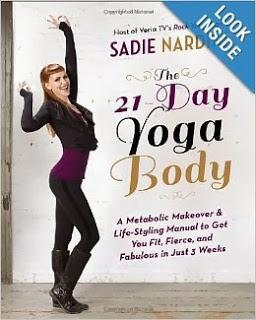Are you familiar with the term “yoga body?” What does it mean to you? Unfortunately, for many people, this term connotes a young, slender, super-bendy woman posing on the cover of a magazine along with promises that doing certain yoga poses will result in “fierce and fabulous” body worthy of a photo shoot. Recently, a book by yoga teacher Sadie Nardini seems to capitalize on this concept:

Here, a young, attractive and very slender woman, who is not even doing yoga on the cover (really, what is that silly position she’s in?), seems to be promising that in 21 days, you’ll have a body that looks like mine!
Of course, if you’re one of our regular readers, you will know that when we talk about the effects of yoga asana on your body, we’re referring to overall physical healthy, including strength, flexibility, balance, agility, and reduced stress levels, not the way you will look after practicing for 21 or more days or the advanced poses you’ll be able to show off. So in general we just tend to ignore mainstream media’s obsession with physical beauty and the resulting distortion of yoga practice. Recently, however, some discussions in the blogosphere as well as at my own dining room table made me realize it would be worthwhile to raise my concerns about this disturbing trend and to take back the term “yoga body.”
First of all, there has been the “scandal” over Lululemon’s founder and CEO Chip Wilson’s statements blaming women’s physical “flaws” for problems in the company’s yoga pants. Yes, people, in explaining why certain women found these expensive pants were pilling, Wilson said that “quite frankly some women’s bodies just actually don’t work for it” and “It’s really about the rubbing through the thighs, how much pressure is there over a period of time and how much they use it.” The take-away here was that if your thighs touch when you stand with your feet together, you don’t have the “yoga body” needed to wear certain “yoga pants.” Do I even have to explain how offensive—and completely antithetical to the real purpose of yoga—this is?
Then, I read some inspiring posts by yoga blogger, Roseanne Harvey, an average-sized yoga practitioner, who decided to test the program in Sadie Nardini’s book and document the results by photographing herself in before and after photos. She decided to do the program for two reasons. The reason first to test the rather ridiculous time frame being promoted. I’ve already written about the issue of being realistic about the time period required for results (see Take Your Time). But it’s very compelling to see the dramatic before and after photos Roseanne took of herself after doing the program. Spoiler alert: she looks basically the same in both photos, possible even a little rounder in the after photo.
But more importantly, Roseanne wanted to take the opportunity to explore the concept of a “yoga body,” asking some of her favorite yoga writers to weigh in on the topic. And she concluded by saying:
“But I’m starting to feel that the “yoga body” is something that needs to be reclaimed (or possibly even claimed; was it ever ours to begin with?). It needs to be reclaimed from Google, reclaimed from marketers, reclaimed from a fragmented culture that has mixed messages and ideas about the human body.”
Yes, Roseanne! I agree wholeheartedly. So this is me joining your movement! And I’d like to add that while most of the discussion around the term “yoga body” focuses on body image and body weight—certainly an vital issue in our culture—what about age? What about the gray hair, wrinkles and sagging flesh that come along with the natural aging of body? My final inspiration for this writing post was seeing this recent photo of BKS Iyengar on the occasion of his 95th birthday.
 How about this as the ultimate “yoga body?” Here is 95-year old man, complete with sagging flesh, white hair, and wrinkled skin, who is still in good physical and mental health, and who is completely comfortable in his skin. In this case, I really do think the picture itself says it all.
How about this as the ultimate “yoga body?” Here is 95-year old man, complete with sagging flesh, white hair, and wrinkled skin, who is still in good physical and mental health, and who is completely comfortable in his skin. In this case, I really do think the picture itself says it all.

